Boyle J.A. The Cambridge History of Iran, Volume 5: The Saljuq and Mongol Periods
Подождите немного. Документ загружается.

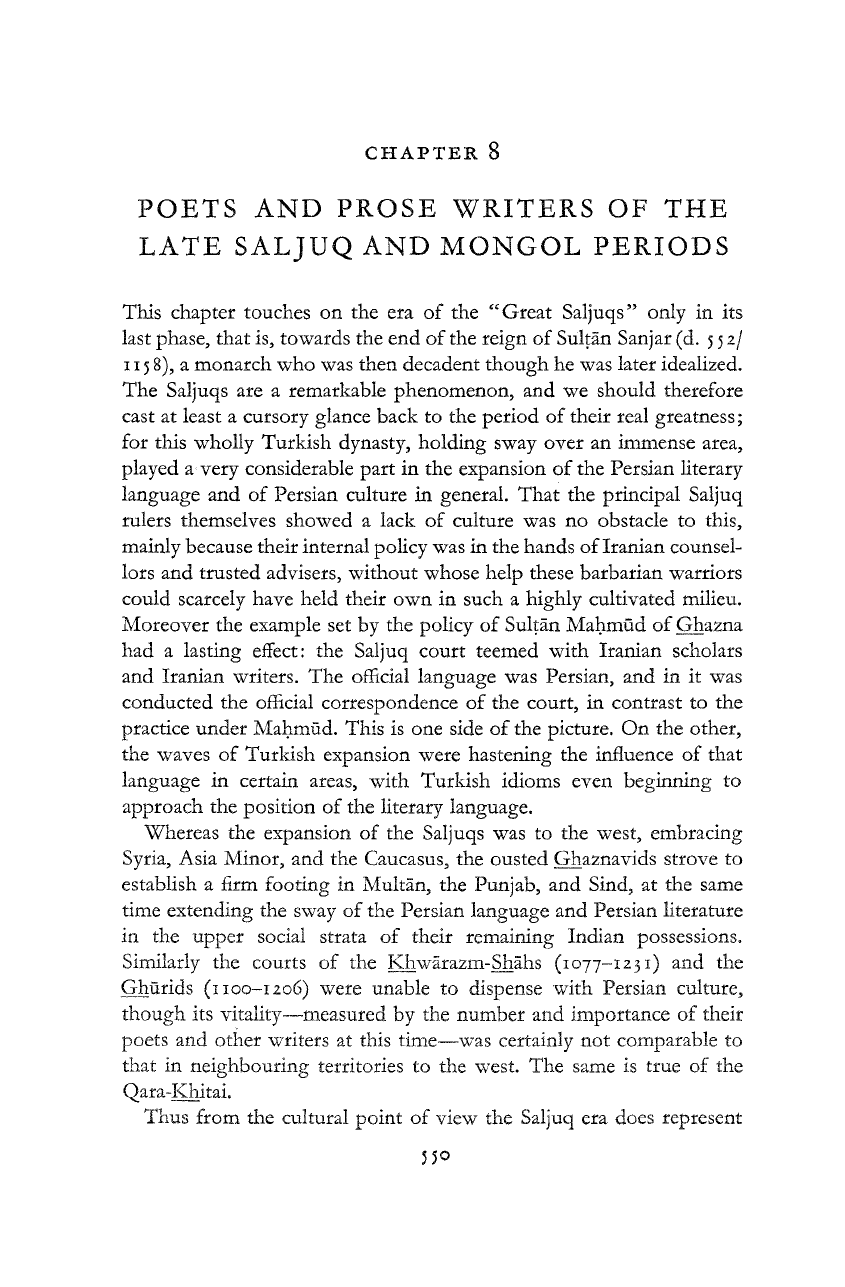
CHAPTER 8
POETS AND PROSE WRITERS OF THE
LATE SALJUQ AND MONGOL PERIODS
This chapter touches on the era of the " Great Saljuqs" only in its
last phase, that is, towards the end of the reign of Sultan Sanjar (d. 552/
115
8),
a monarch who was then decadent though he was later idealized.
The Saljuqs are a remarkable phenomenon, and we should therefore
cast at least a cursory glance back to the period of their real greatness;
for this wholly Turkish dynasty, holding sway over an immense area,
played a very considerable part in the expansion of the Persian literary
language and of Persian culture in general. That the principal Saljuq
rulers themselves showed a lack of culture was no obstacle to this,
mainly because their internal policy was in the hands of Iranian counsel-
lors and trusted advisers, without whose help these barbarian warriors
could scarcely have held their own in such a highly cultivated milieu.
Moreover the example set by the policy of Sultan Mahmüd of Ghazna
had a lasting effect: the Saljuq court teemed with Iranian scholars
and Iranian writers. The official language was Persian, and in it was
conducted the official correspondence of the court, in contrast to the
practice under Mahmüd. This is one side of the picture. On the other,
the waves of Turkish expansion were hastening the influence of that
language in certain areas, with Turkish idioms even beginning to
approach the position of the literary language.
Whereas the expansion of the Saljuqs was to the west, embracing
Syria, Asia Minor, and the Caucasus, the ousted Ghaznavids strove to
establish a firm footing in Multan, the Punjab, and Sind, at the same
time extending the sway of the Persian language and Persian literature
in the upper social strata of their remaining Indian possessions.
Similarly the courts of the Khwarazm-Shähs (1077-1231) and the
Ghürids (1100-1206) were unable to dispense with Persian culture,
though its vitality—measured by the number and importance of their
poets and other writers at this time—was certainly not comparable to
that in neighbouring territories to the west. The same is true of the
Qara-Khitai.
Thus from the cultural point of view the Saljuq era does represent
550
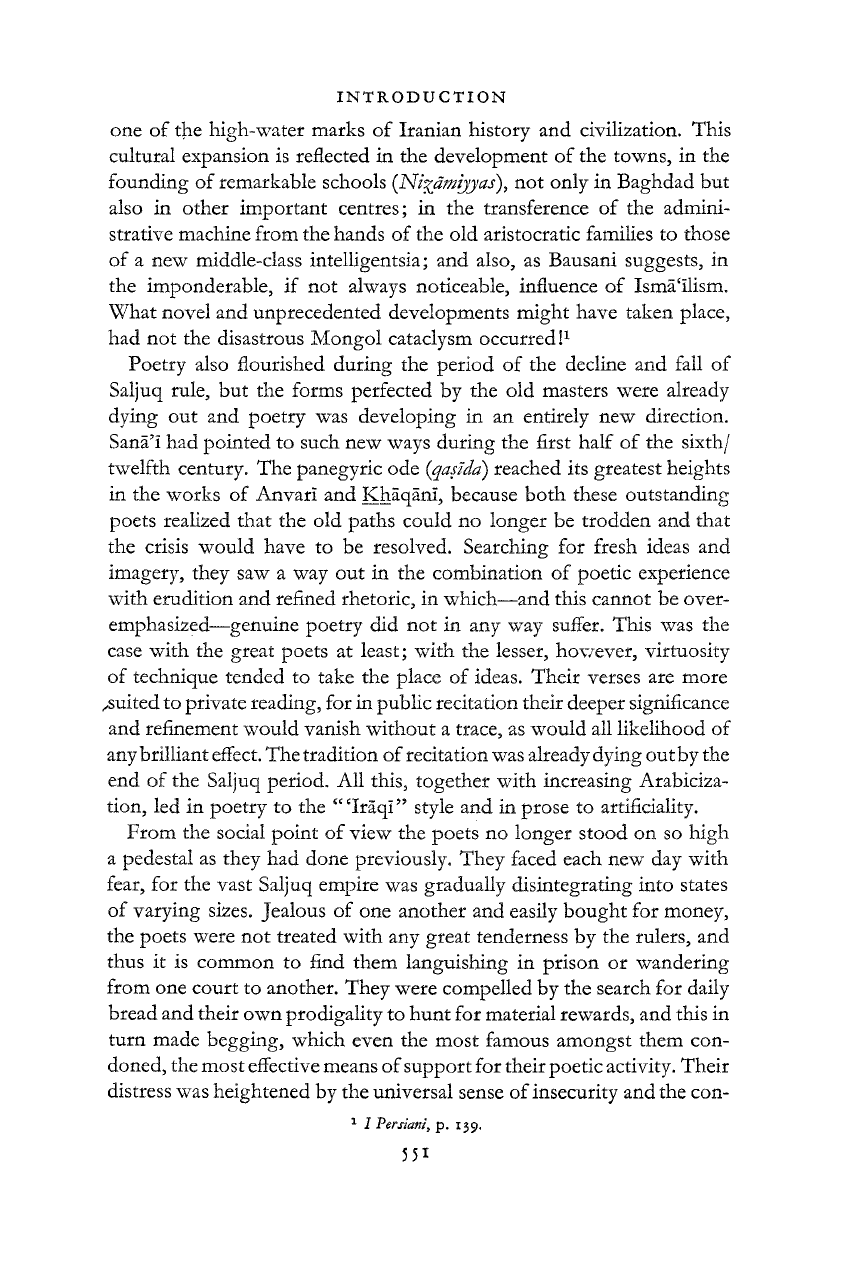
INTRODUCTION
one
of the
high-water marks
of
Iranian history
and
civilization. This
cultural expansion
is
reflected
in the
development
of
the towns,
in the
founding
of
remarkable schools
(Ni^amiyjas), not
only
in
Baghdad
but
also
in
other important centres;
in the
transference
of the
admini-
strative machine from the hands
of
the
old
aristocratic families
to
those
of
a new
middle-class intelligentsia;
and
also,
as
Bausani suggests,
in
the imponderable,
if not
always noticeable, influence
of
Isma'ilism.
What novel and unprecedented developments might have taken place,
had
not the
disastrous Mongol cataclysm occurred!
1
Poetry also flourished during
the
period
of the
decline
and
fall
of
Saljuq rule,
but the
forms perfected
by the old
masters were already
dying
out and
poetry
was
developing
in an
entirely
new
direction.
Sana'i
had
pointed
to
such
new
ways during
the
first half
of the
sixth/
twelfth century.
The
panegyric
ode (qanda)
reached
its
greatest heights
in
the
works
of
Anvari
and
Khaqani, because both these outstanding
poets realized that
the old
paths could
no
longer
be
trodden
and
that
the crisis would have
to be
resolved. Searching
for
fresh ideas
and
imagery, they
saw a way out in the
combination
of
poetic experience
with erudition
and
refined rhetoric,
in
which—and this cannot
be
over-
emphasized—genuine poetry
did not in any way
suffer. This
was the
case with
the
great poets
at
least; with
the
lesser, however, virtuosity
of technique tended
to
take
the
place
of
ideas. Their verses
are
more
•suited
to
private reading,
for
in public recitation their deeper significance
and refinement would vanish without
a
trace,
as
would
all
likelihood
of
any brilliant effect. The tradition
of
recitation was already dying out by the
end
of the
Saljuq period.
All
this, together with increasing Arabiciza-
tion,
led in
poetry
to the
"'Iraqi" style
and in
prose
to
artificiality.
From
the
social point
of
view
the
poets
no
longer stood
on so
high
a pedestal
as
they
had
done previously. They faced each
new day
with
fear,
for the
vast Saljuq empire
was
gradually disintegrating into states
of varying sizes. Jealous
of one
another
and
easily bought
for
money,
the poets were
not
treated with
any
great tenderness
by the
rulers,
and
thus
it is
common
to
find them languishing
in
prison
or
wandering
from
one
court
to
another. They were compelled
by the
search
for
daily
bread and their own prodigality
to
hunt
for
material rewards, and this
in
turn made begging, which even
the
most famous amongst them con-
doned, the most effective means of support
for
their poetic activity. Their
distress was heightened
by
the universal sense
of
insecurity and the con-
1
I
Persian^
p. 139.
551
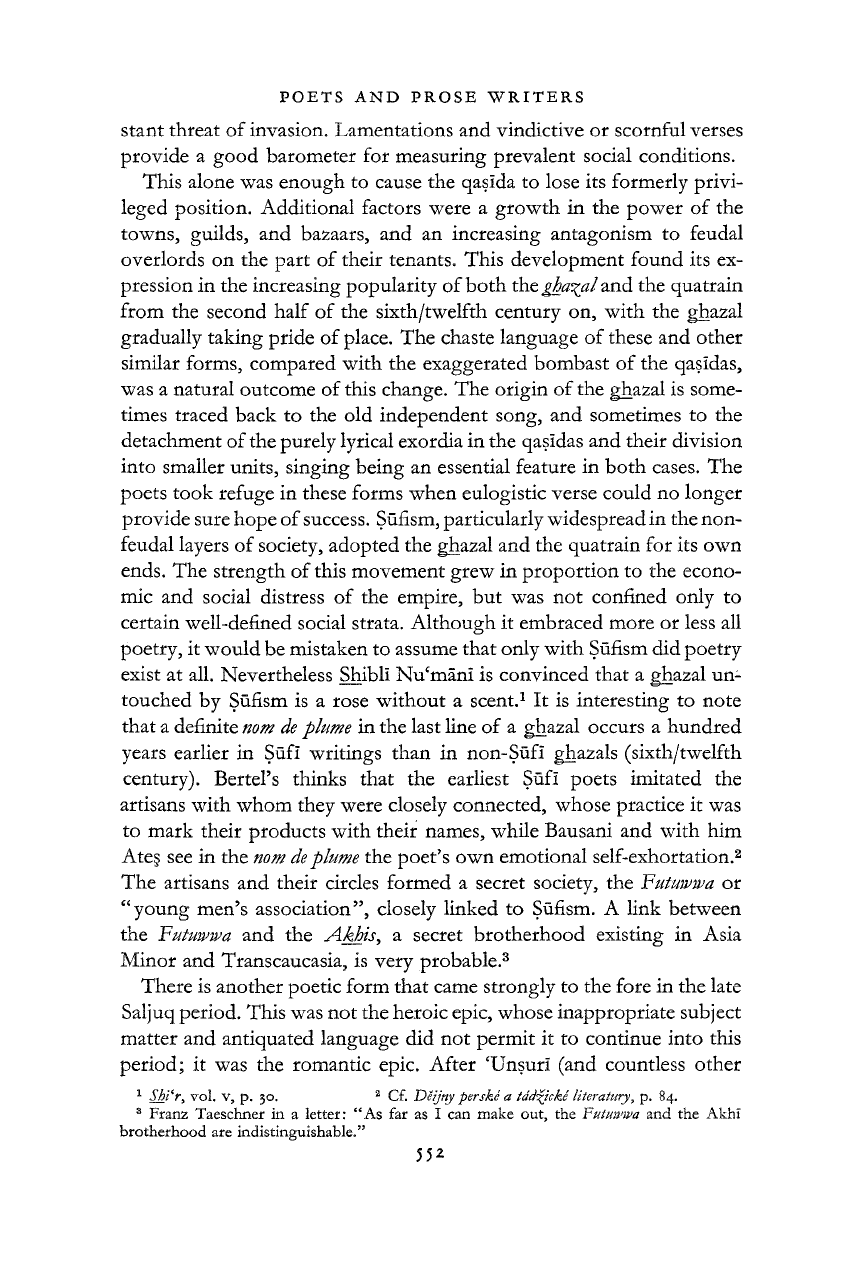
POETS
AND
PROSE WRITERS
552
stant threat
of
invasion. Lamentations
and
vindictive
or
scornful verses
provide
a
good barometer
for
measuring prevalent social conditions.
This alone
was
enough
to
cause
the
qasida
to
lose
its
formerly privi-
leged position. Additional factors were
a
growth
in the
power
of the
towns, guilds,
and
bazaars,
and an
increasing antagonism
to
feudal
overlords
on the
part
of
their tenants. This development found
its ex-
pression
in the
increasing popularity
of
both
the ghazal
and
the
quatrain
from
the
second half
of the
sixth/twelfth century
on,
with
the
ghazal
gradually taking pride
of
place.
The
chaste language
of
these
and
other
similar forms, compared with
the
exaggerated bombast
of
the qasidas,
was
a
natural outcome
of
this change.
The
origin
of
the ghazal
is
some-
times traced back
to the old
independent song,
and
sometimes
to the
detachment
of
the purely lyrical exordia
in
the qasidas
and
their division
into smaller units, singing being
an
essential feature
in
both cases.
The
poets took refuge
in
these forms when eulogistic verse could
no
longer
provide sure hope
of
success. Süfism, particularly widespread in the non-
feudal layers
of
society, adopted
the
ghazal
and the
quatrain
for its own
ends.
The
strength
of
this movement grew
in
proportion
to the
econo-
mic
and
social distress
of the
empire,
but was not
confined only
to
certain well-defined social strata. Although
it
embraced more
or
less
all
poetry,
it
would be mistaken
to
assume that only with Süfism did poetry
exist
at
all. Nevertheless Shibli Nu
c
mäní
is
convinced that
a
ghazal
un-
touched
by
Süfism
is a
rose without
a
scent.
1
It is
interesting
to
note
that
a
definite
nom de plume in
the last line
of a
ghazal occurs
a
hundred
years earlier
in
Süfi writings than
in
non-Süfi ghazals (sixth/twelfth
century).
Berteľs thinks that
the
earliest Süfi poets imitated
the
artisans with whom they were closely connected, whose practice
it was
to mark their products with their names, while Bausani
and
with
him
Ate§
see in the nom de plume the
poet's
own
emotional self-exhortation.
2
The artisans
and
their circles formed
a
secret society,
the Futuwwa or
"young men's association", closely linked
to
Süfism.
A
link between
the
Futuwwa and the Akhis^ &
secret brotherhood existing
in
Asia
Minor
and
Transcaucasia,
is
very probable.
3
There
is
another poetic form that came strongly
to the
fore
in the
late
Saljuq period. This was not the heroic epic, whose inappropriate subject
matter
and
antiquated language
did not
permit
it to
continue into this
period;
it was the
romantic epic. After 'Unsuri
(and
countless other
1
Shťr> vol.
v, p. 30.
2
Cf.
Deijny perské a tadžické
literatúry,
p. 84.
3
Franz Taeschner
in a
letter:
"As far as I can
make
out, the
Futmmva
and the
Akhi
brotherhood are indistinguishable."
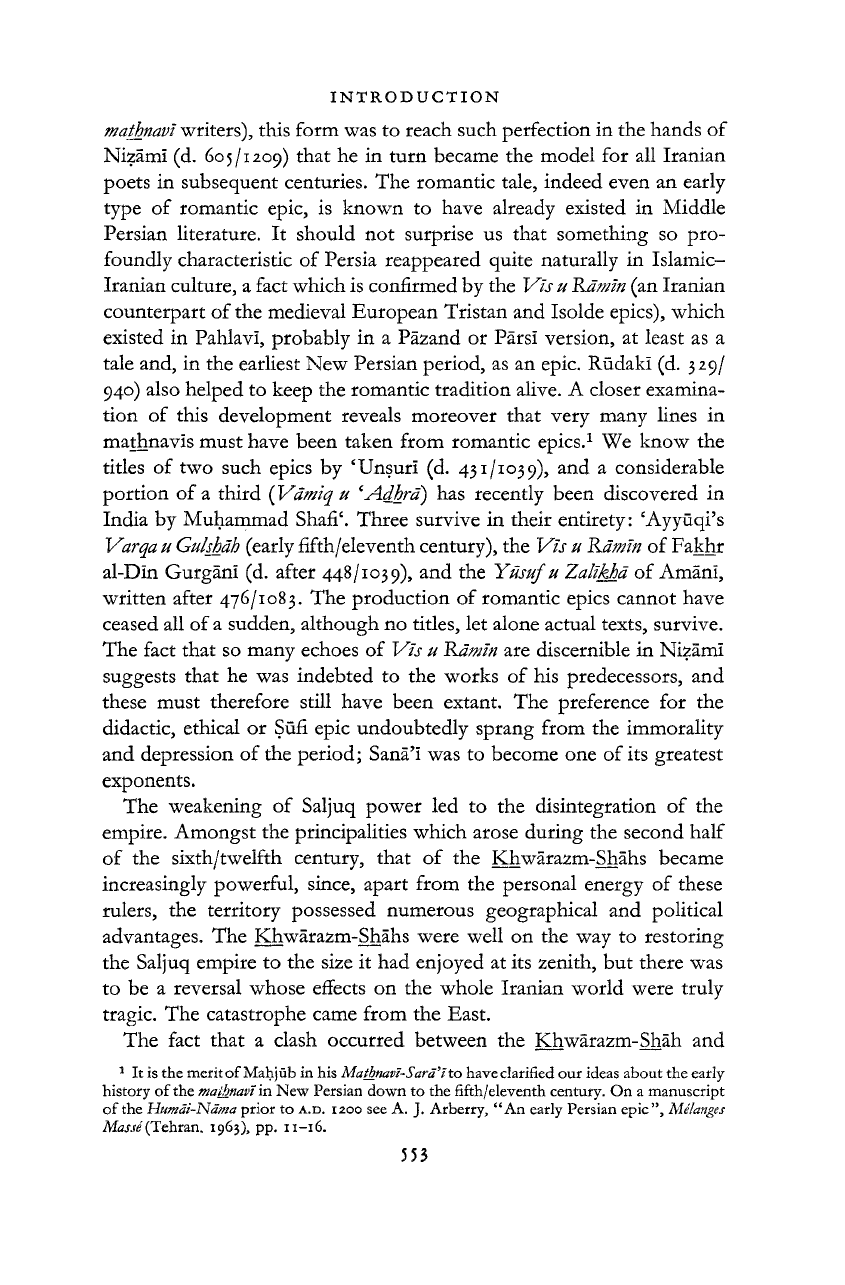
INTRODUCTION
mathnavī
writers), this form was
to
reach such perfection
in the
hands
of
Nizami
(d.
605/1209) that
he in
turn became
the
model
for all
Iranian
poets
in
subsequent centuries.
The
romantic tale, indeed even
an
early
type
of
romantic epic,
is
known
to
have already existed
in
Middle
Persian literature.
It
should
not
surprise
us
that something
so
pro-
foundly characteristic
of
Persia reappeared quite naturally
in
Islamic-
Iranian culture,
a
fact which
is
confirmed
by
the
Vīs u Rāmīn
(an Iranian
counterpart
of
the medieval European Tristan
and
Isolde epics), which
existed
in
Pahlavi, probably
in a
Pāzand
or
Pārsi version,
at
least
as a
tale and,
in the
earliest
New
Persian period,
as an
epic. Rudāki
(d. 329/
940) also helped
to
keep
the
romantic tradition alive.
A
closer examina-
tion
of
this development reveals moreover that very many lines
in
mathnavis must have been taken from romantic epics.
1
We
know
the
titles
of two
such epics
by
'Unsuri
(d.
431/1039),
and a
considerable
portion
of a
third
(Vamiq u 'Adhra) has
recently been discovered
in
India
by
Muhammad Shafi
c
. Three survive
in
their entirety: 'Ayyuqi's
Varqa u Gulshāh
(early fifth/eleventh century),
the Vīs u Rāmīn of
Fakhr
al-Din Gurgani
(d.
after 448/1039),
and the Yusuf u Zalīkhā of
Amani,
written after 476/1083.
The
production
of
romantic epics cannot have
ceased
all of
a sudden, although
no
titles,
let
alone actual texts, survive.
The fact that
so
many echoes
of Vīs u Rāmīn are
discernible
in
Nizāmi
suggests that
he was
indebted
to the
works
of his
predecessors,
and
these must therefore still have been extant.
The
preference
for the
didactic, ethical
or
Sufi epic undoubtedly sprang from
the
immorality
and depression
of
the period; Sanā'ī
was to
become
one of
its greatest
exponents.
The weakening
of
Saljuq power
led to the
disintegration
of the
empire. Amongst
the
principalities which arose during
the
second half
of
the
sixth/twelfth century, that
of the
Khwarazm-Shahs became
increasingly powerful, since, apart from
the
personal energy
of
these
rulers,
the
territory possessed numerous geographical
and
political
advantages.
The
Khwarazm-Shahs were well
on the way to
restoring
the Saljuq empire
to the
size
it had
enjoyed
at its
zenith,
but
there
was
to
be a
reversal whose effects
on the
whole Iranian world were truly
tragic.
The
catastrophe came from
the
East.
The fact that
a
clash occurred between
the
Khwarazm- Shāh
and
1
It
is the
merit
of Mahjūb in his
Mathnavī-Sarā'/
to have clarified our ideas about the early-
history
of
the
mathnavī
in New Persian down
to
the
fifth/eleventh
century.
On
a manuscript
of the Humāi-Nāma prior
to
A.D.
1200 see
A. J.
Arberry,
"An
early Persian epic", Melanges
Masse (Tehran. 1963), pp. 11-16.
553
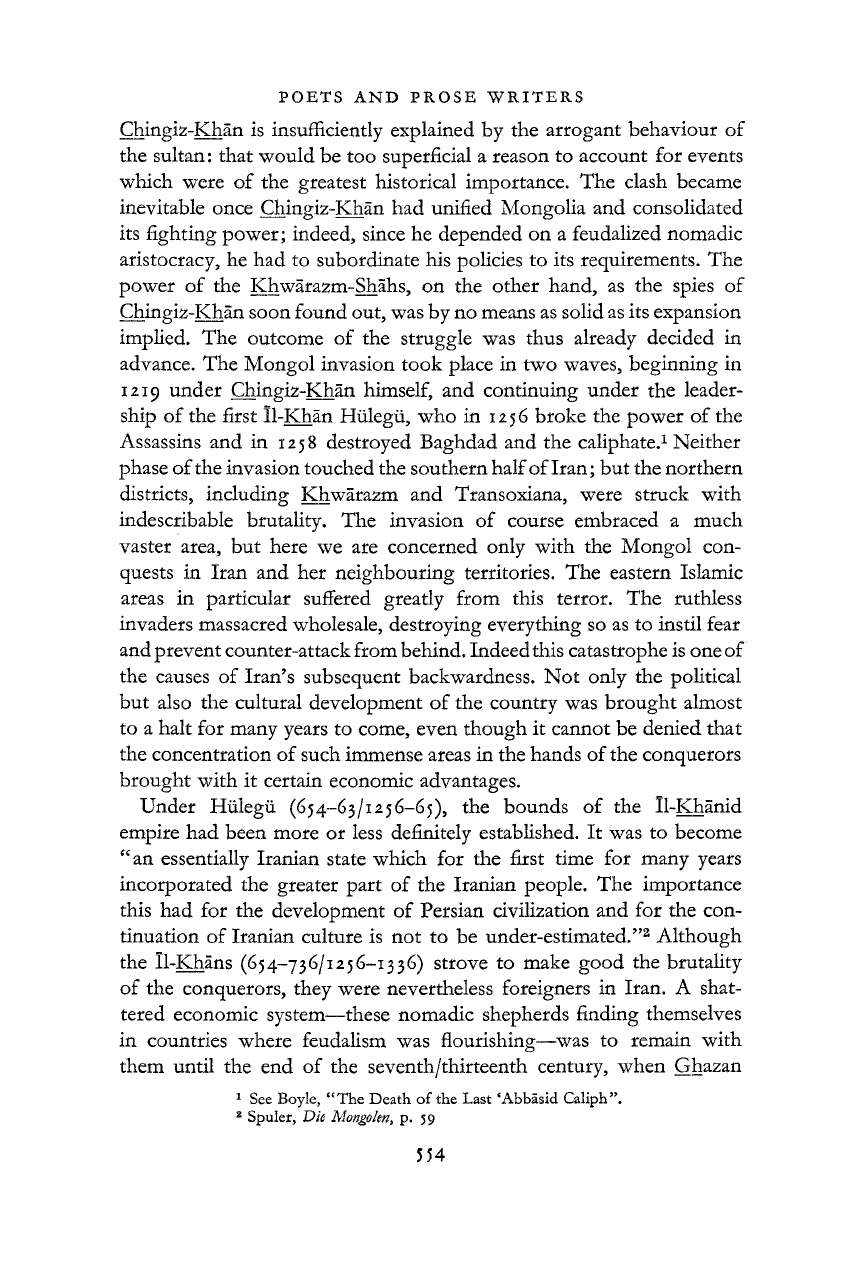
POETS AND PROSE WRITERS
554
Chingiz-Khän is insufficiently explained by the arrogant behaviour of
the sultan: that would be too superficial a reason to account for events
which were of the greatest historical importance. The clash became
inevitable once Chingiz-Khän had unified Mongolia and consolidated
its fighting power; indeed, since he depended on a feudalized nomadic
aristocracy, he had to subordinate his policies to its requirements. The
power of the Khwarazm-Shahs, on the other hand, as the spies of
Chingiz-Khän soon found out, was by no means as solid as its expansion
implied. The outcome of the struggle was thus already decided in
advance. The Mongol invasion took place in two waves, beginning in
1219 under Chingiz-Khän himself, and continuing under the leader-
ship of the first Il-Khän Húlegú, who in 1256 broke the power of the
Assassins and in 1258 destroyed Baghdad and the caliphate.
1
Neither
phase of the invasion touched the southern half of Iran; but the northern
districts, including Khwärazm and Transoxiana, were struck with
indescribable brutality. The invasion of course embraced a much
vaster area, but here we are concerned only with the Mongol con-
quests in Iran and her neighbouring territories. The eastern Islamic
areas in particular suffered greatly from this terror. The ruthless
invaders massacred wholesale, destroying everything so as to instil fear
and prevent counter-attack from behind. Indeed this catastrophe is one of
the causes of Iran's subsequent backwardness. Not only the political
but also the cultural development of the country was brought almost
to a halt for many years to come, even though it cannot be denied that
the concentration of such immense areas in the hands of the conquerors
brought with it certain economic advantages.
Under Húlegú (654-63/1256-65), the bounds of the Il-Khanid
empire had been more or less definitely established. It was to become
"an essentially Iranian state which for the first time for many years
incorporated the greater part of the Iranian people. The importance
this had for the development of Persian civilization and for the con-
tinuation of Iranian culture is not to be under-estimated."
2
Although
the Il-Khäns (654-736/1256-1336) strove to make good the brutality
of the conquerors, they were nevertheless foreigners in Iran. A shat-
tered economic system—these nomadic shepherds finding themselves
in countries where feudalism was flourishing—was to remain with
them until the end of the seventh/thirteenth century, when Ghazan
1
See Boyle, "The Death of the Last 'Abbäsid Caliph".
2
Spuler, Die Mongokn
i
p. 59
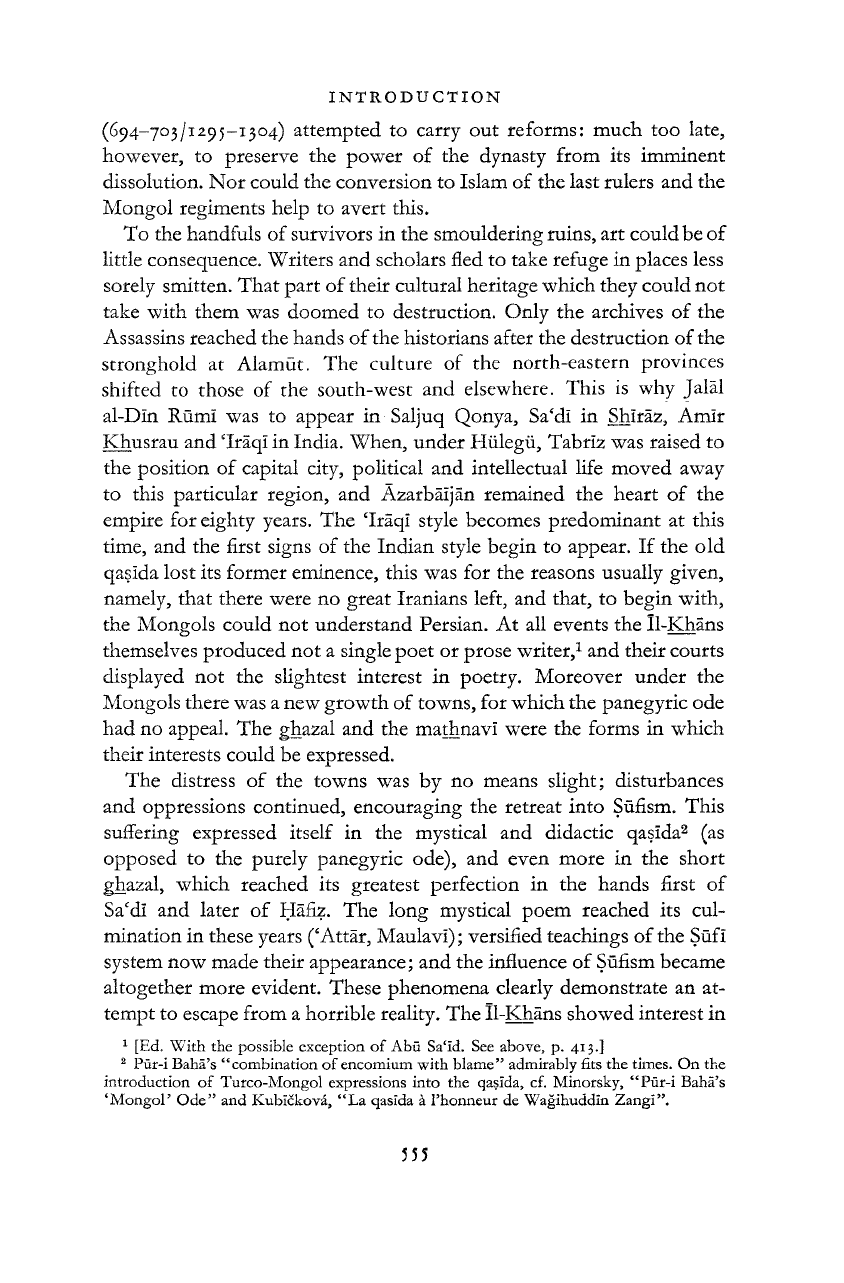
INTRODUCTION
555
(694-703/1295-1304) attempted to carry out reforms: much too late,
however, to preserve the power of the dynasty from its imminent
dissolution. Nor could the conversion to Islam of the last rulers and the
Mongol regiments help to avert this.
To the handfuls of survivors in the smouldering ruins, art could be of
little consequence. Writers and scholars fled to take refuge in places less
sorely smitten. That part of their cultural heritage which they could not
take with them was doomed to destruction. Only the archives of the
Assassins reached the hands of the historians after the destruction of the
stronghold at Alamüt. The culture of the north-eastern provinces
shifted to those of the south-west and elsewhere. This is why Jalàl
al-Din Rümï was to appear in Saljuq Qonya, Sa'di in Shiraz, Amir
Khusrau and 'Iraqi in India. When, under Hülegü, Tabriz was raised to
the position of capital city, political and intellectual life moved away
to this particular region, and Àzarbàijàn remained the heart of the
empire for eighty years. The 'Iraqi style becomes predominant at this
time, and the first signs of the Indian style begin to appear. If the old
qasida lost its former eminence, this was for the reasons usually given,
namely, that there were no great Iranians left, and that, to begin with,
the Mongols could not understand Persian. At all events the Il-Khans
themselves produced not a single poet or prose writer,
1
and their courts
displayed not the slightest interest in poetry. Moreover under the
Mongols there was a new growth of towns, for which the panegyric ode
had no appeal. The ghazal and the mathnavi were the forms in which
their interests could be expressed.
The distress of the towns was by no means slight; disturbances
and oppressions continued, encouraging the retreat into Süfism. This
suffering expressed itself in the mystical and didactic qasida
2
(as
opposed to the purely panegyric ode), and even more in the short
ghazal, which reached its greatest perfection in the hands first of
Sa'di and later of Hafiz. The long mystical poem reached its cul-
mination in these years ('Attar, Maulavi); versified teachings of the Sufi
system now made their appearance; and the influence of Süfism became
altogether more evident. These phenomena clearly demonstrate an at-
tempt to escape from a horrible reality. The Il-Khans showed interest in
1
[Ed. With the possible exception of Abü Sa'id. See above, p. 413.]
2
Pür-i Bahà's "combination of encomium with blame" admirably fits the times. On the
introduction of Turco-Mongol expressions into the qasida, cf. Minorsky, "
Pür-i
Bahà's
*
Mongol' Ode" and Kubíčková, "La qasïda à l'honneur de Wagihuddïn Zangi".
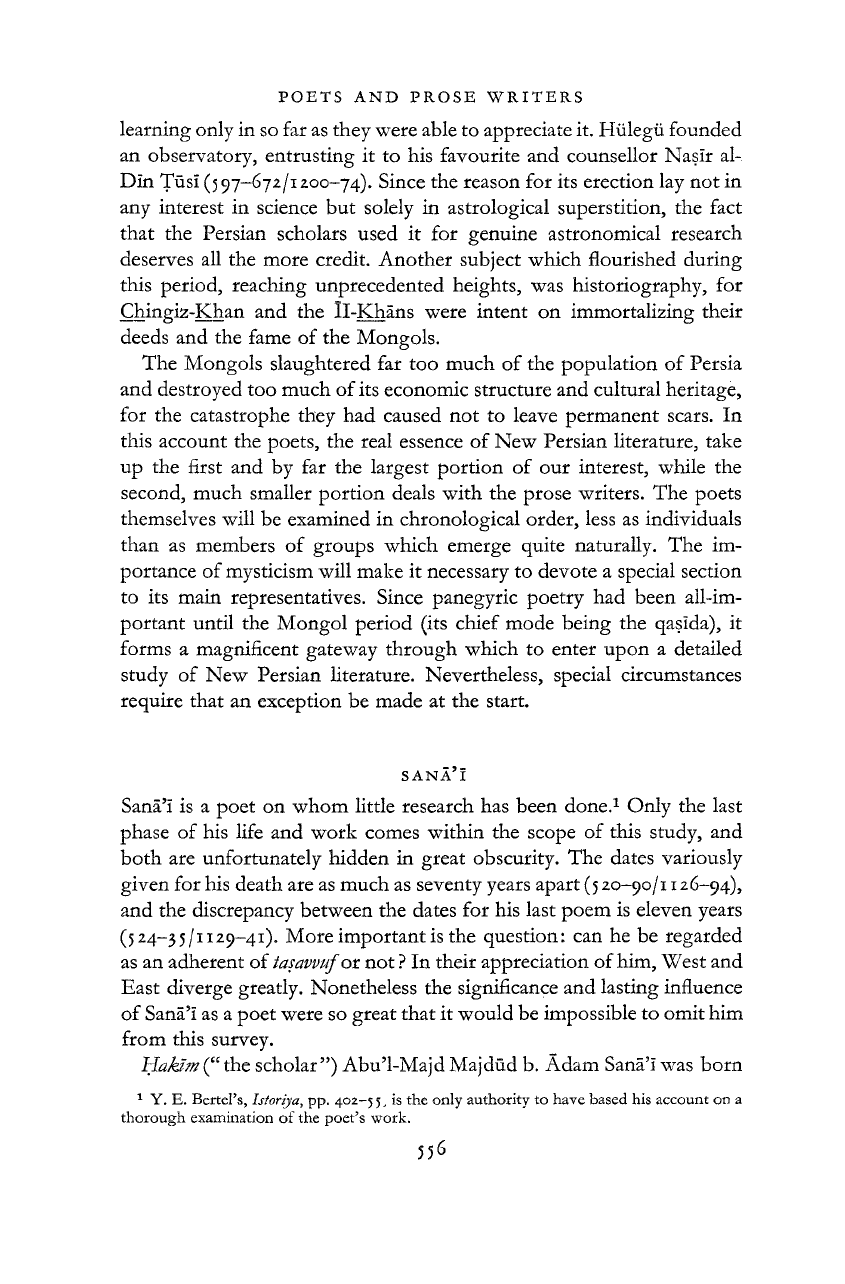
POETS
AND
PROSE WRITERS
learning only
in so far
as they were able
to
appreciate it. Hülegü founded
an observatory, entrusting
it to his
favourite
and
counsellor Naşir
al-
Din Tüsi
(5
97-672/1200-74). Since
the
reason
for its
erection
lay not in
any interest
in
science
but
solely
in
astrological superstition,
the
fact
that
the
Persian scholars used
it for
genuine astronomical research
deserves
all the
more credit. Another subject which flourished during
this period, reaching unprecedented heights,
was
historiography,
for
Chingiz-Khan
and the
Il-Khâns were intent
on
immortalizing their
deeds
and the
fame
of
the Mongols.
The Mongols slaughtered
far too
much
of the
population
of
Persia
and destroyed
too
much
of
its economic structure
and
cultural heritage,
for
the
catastrophe they
had
caused
not to
leave permanent scars.
In
this account
the
poets,
the
real essence
of New
Persian literature, take
up
the
first
and by far the
largest portion
of our
interest, while
the
second, much smaller portion deals with
the
prose writers.
The
poets
themselves will
be
examined
in
chronological order, less
as
individuals
than
as
members
of
groups which emerge quite naturally.
The im-
portance
of
mysticism will make
it
necessary
to
devote
a
special section
to
its
main representatives. Since panegyric poetry
had
been all-im-
portant until
the
Mongol period
(its
chief mode being
the
qasida),
it
forms
a
magnificent gateway through which
to
enter upon
a
detailed
study
of New
Persian literature. Nevertheless, special circumstances
require that
an
exception
be
made
at the
start.
SANA'I
Sana'i
is a
poet
on
whom little research
has
been done.
1
Only
the
last
phase
of his
life
and
work comes within
the
scope
of
this study,
and
both
are
unfortunately hidden
in
great obscurity.
The
dates variously
given
for
his death are
as
much as seventy years apart
(5
20-90/1126-94),
and
the
discrepancy between
the
dates
for his
last poem
is
eleven years
(5
24-3 5/1129-41). More important
is the
question:
can he be
regarded
as
an
adherent
of
tasavvuf
or not
?
In
their appreciation
of
him, West and
East diverge greatly. Nonetheless
the
significance
and
lasting influence
of Sana'i as
a
poet were
so
great that
it
would
be
impossible
to
omit him
from this survey.
Hakim
("
the scholar") Abu'l-Majd Majdud
b.
Adam Sana'i was born
1
Y. E.
Bertel's,
Istoriya,
pp. 402-55,
is
the only authority
to
have based his account on
a
thorough examination
of
the poet's work.
556
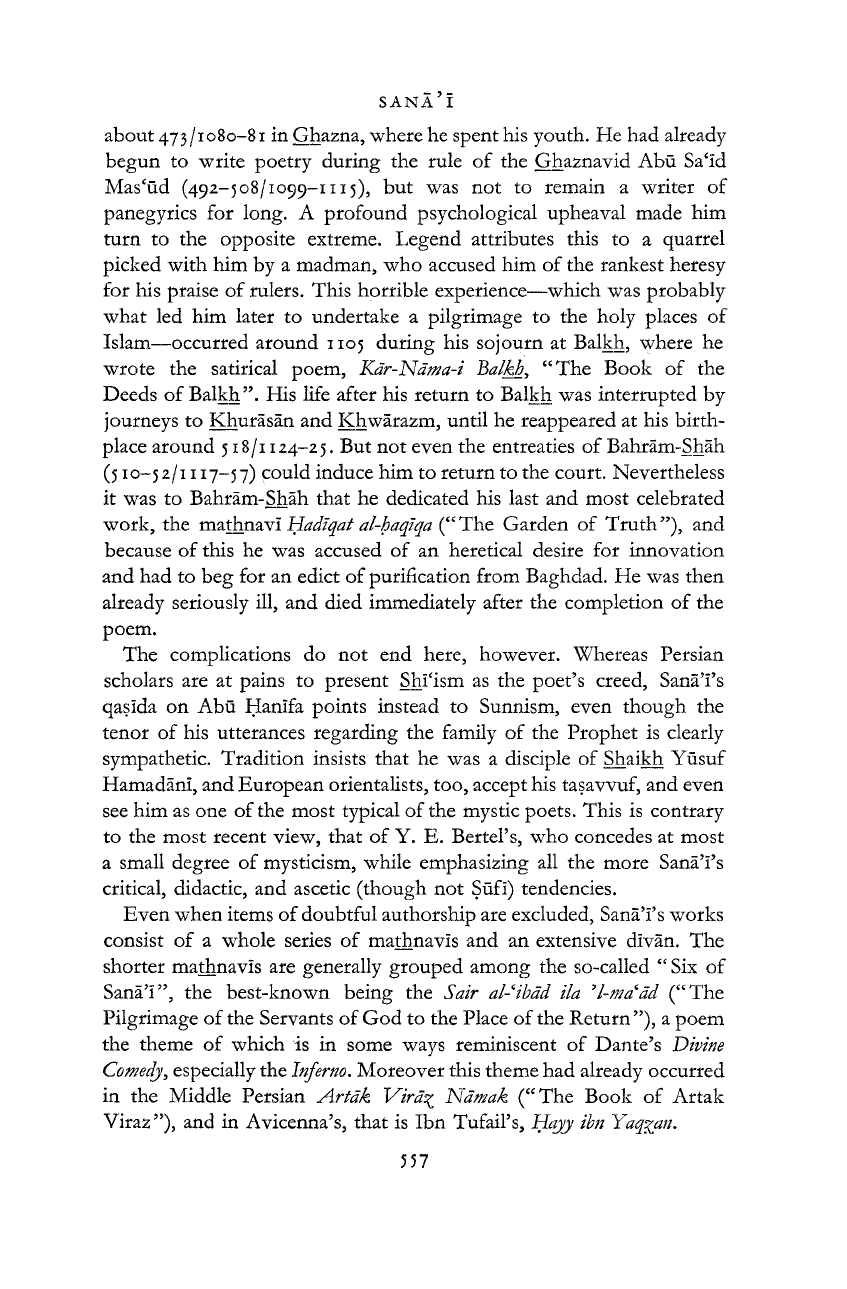
SANA'I
about 473/1080-81
in
Ghazna, where
he
spent his youth.
He had
already
begun
to
write poetry during
the
rule
of the
Ghaznavid
Abu
Sa'id
Mas'ud (492-508/1099-1115),
but was not to
remain
a
writer
of
panegyrics
for
long.
A
profound psychological upheaval made
him
turn
to the
opposite extreme. Legend attributes this
to a
quarrel
picked with
him by a
madman,
who
accused
him of
the rankest heresy
for
his
praise
of
rulers. This horrible experience—which
was
probably
what
led him
later
to
undertake
a
pilgrimage
to the
holy places
of
Islam—occurred around
1105
during
his
sojourn
at
Balkh, where
he
wrote
the
satirical poem,
Kdr-Ndma-i Balkh, "The
Book
of the
Deeds
of
Balkh".
His
life after
his
return
to
Balkh
was
interrupted
by
journeys
to
Khurasan
and
Khwarazm, until
he
reappeared
at his
birth-
place around 518/1124-2
5.
But not
even
the
entreaties
of
Bahrain-Shah
(510-52/1117-57) could induce him
to
return
to
the court. Nevertheless
it
was to
Bahram-Shah that
he
dedicated
his
last
and
most celebrated
work,
the
mathnavi
Hadiqat al-haqiqa ("The
Garden
of
Truth"),
and
because
of
this
he was
accused
of an
heretical desire
for
innovation
and
had to beg for an
edict
of
purification from Baghdad.
He was
then
already seriously
ill, and
died immediately after
the
completion
of the
poem.
The complications
do not end
here, however. Whereas Persian
scholars
are at
pains
to
present Shi'ism
as the
poet's creed, Sana'i's
qasida
on Abu.
Hanifa points instead
to
Sunnism, even though
the
tenor
of his
utterances regarding
the
family
of the
Prophet
is
clearly
sympathetic. Tradition insists that
he was a
disciple
of
Shaikh Yusuf
Hamadani, and European orientalists, too, accept his tasavvuf, and even
see him
as one of
the most typical
of
the mystic poets. This
is
contrary
to
the
most recent view, that
of Y. E.
Bertel's,
who
concedes
at
most
a small degree
of
mysticism, while emphasizing
all the
more Sana'i's
critical, didactic,
and
ascetic (though
not
Sufi) tendencies.
Even when items
of
doubtful authorship are excluded, Sana'i's works
consist
of a
whole series
of
mathnavis
and an
extensive divan.
The
shorter mathnavis
are
generally grouped among
the
so-called
"
Six
of
Sana'i",
the
best-known being
the Sair al-ibdd ila 'l-ma'dd ("
The
Pilgrimage
of
the Servants
of
God
to the
Place
of
the Return
"),
a
poem
the theme
of
which
is in
some ways reminiscent
of
Dante's
Divine
Comedyľ,
especially the
Inferno.
Moreover this theme had already occurred
in
the
Middle Persian
Artdk
Vird^
Ndmak ("The
Book
of
Artak
Viraz"),
and in
Avicenna's, that
is Ibn
Tufail's,
Hqyj ibn
Yaq^atu
557
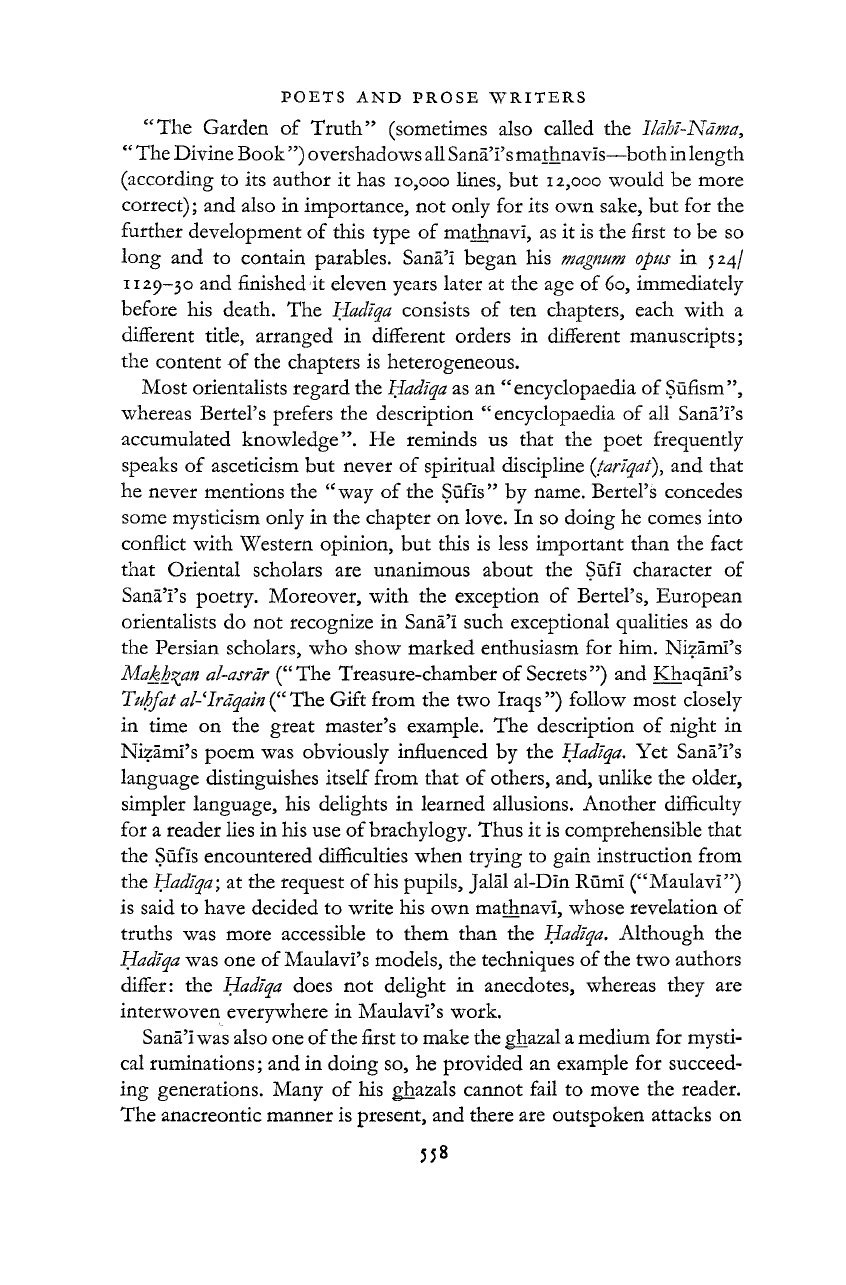
POETS
AND
PROSE WRITERS
558
"The Garden
of
Truth" (sometimes also called
the Ildhl-Ndma,
" The Divine Book ") overshadows all Sana'i's mathnavis—both in length
(according
to its
author
it has
10,000 lines,
but
12,000 would
be
more
correct);
and
also
in
importance,
not
only
for its own
sake,
but for the
further development
of
this type
of
mathnavi,
as it is the
first
to be so
long
and to
contain parables. Sana'i began
his magnum opus in 524/
1129-30
and
finished
it
eleven years later
at the age of
60, immediately
before
his
death.
The Hadlqa
consists
of ten
chapters, each with
a
different title, arranged
in
different orders
in
different manuscripts;
the content
of
the chapters
is
heterogeneous.
Most orientalists regard
the Hadlqa as an "
encyclopaedia
of
Sufism",
whereas Bertel's prefers
the
description "encyclopaedia
of all
Sana'i's
accumulated knowledge".
He
reminds
us
that
the
poet frequently
speaks
of
asceticism
but
never
of
spiritual discipline
{tariqat\
and
that
he never mentions
the "way of the
Sufis"
by
name. Bertel's concedes
some mysticism only
in the
chapter
on
love.
In so
doing
he
comes into
conflict with Western opinion,
but
this
is
less important than
the
fact
that Oriental scholars
are
unanimous about
the
Sufi character
of
Sana'i's poetry. Moreover, with
the
exception
of
Bertel's, European
orientalists
do not
recognize
in
Sana'I such exceptional qualities
as do
the Persian scholars,
who
show marked enthusiasm
for
him. Nizami's
Makh^an al-asrdr ("The
Treasure-chamber
of
Secrets")
and
Khaqani's
Tuhfat al'Irdqain ("
The Gift from
the two
Iraqs") follow most closely
in time
on the
great master's example.
The
description
of
night
in
Nizami's poem
was
obviously influenced
by the Hadlqa. Yet
Sana'i's
language distinguishes itself from that
of
others, and, unlike
the
older,
simpler language,
his
delights
in
learned allusions. Another difficulty
for
a
reader lies
in
his
use of
brachylogy. Thus
it is
comprehensible that
the Sufis encountered difficulties when trying
to
gain instruction from
the
Hadlqa
\
at the
request
of
his pupils, Jalal al-Din Rumi ("Maulavi")
is said
to
have decided
to
write
his own
mathnavi, whose revelation
of
truths
was
more accessible
to
them than
the Hadlqa.
Although
the
Hadlqa
was
one of
Maulavi's models,
the
techniques
of
the
two
authors
differ:
the Hadlqa
does
not
delight
in
anecdotes, whereas they
are
interwoven everywhere
in
Maulavi's work.
Sana'I was also one
of
the first
to
make the ghazal
a
medium
for
mysti-
cal ruminations; and
in
doing
so, he
provided
an
example
for
succeed-
ing generations. Many
of his
ghazals cannot fail
to
move
the
reader.
The anacreontic manner
is
present,
and
there
are
outspoken attacks
on
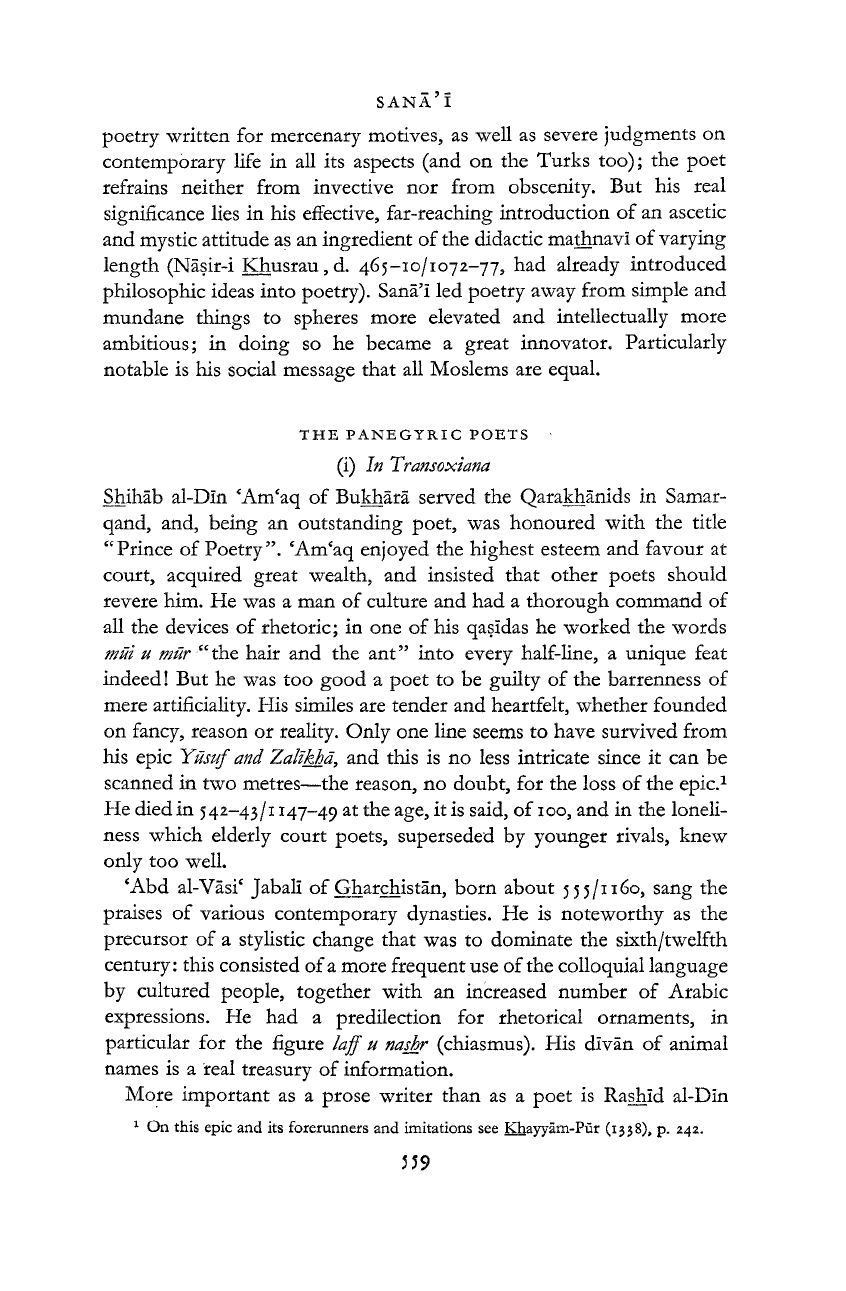
SANA'
ī
poetry written
for
mercenary motives,
as
well
as
severe judgments
on
contemporary life
in all its
aspects
(and on the
Turks
too); the
poet
refrains neither from invective
nor
from obscenity.
But his
real
significance lies
in his
effective, far-reaching introduction
of an
ascetic
and mystic attitude
as an
ingredient
of
the didactic mathnavi
of
varying
length (Nāsir-i Khusrau,
d.
465-10/1072-77,
had
already introduced
philosophic ideas into poetry). Sanā'i
led
poetry away from simple
and
mundane things
to
spheres more elevated
and
intellectually more
ambitious;
in
doing
so he
became
a
great innovator. Particularly
notable
is his
social message that
all
Moslems
are
equal.
THE PANEGYRIC POETS
(i)
In
Transoxiana
Shihāb al-Din 'Am'aq
of
Bukhara served
the
Qarakhanids
in
Samar-
qand,
and,
being
an
outstanding poet,
was
honoured with
the
title
"Prince
of
Poetry". 'Am'aq enjoyed
the
highest esteem
and
favour
at
court, acquired great wealth,
and
insisted that other poets should
revere him.
He was a man of
culture
and had a
thorough command
of
all
the
devices
of
rhetoric;
in one of
his qasidas
he
worked
the
words
mūi u mūr "the
hair
and the ant"
into every half-line,
a
unique feat
indeed!
But he was too
good
a
poet
to be
guilty
of the
barrenness
of
mere artificiality.
His
similes
are
tender
and
heartfelt, whether founded
on fancy, reason
or
reality. Only
one
line seems
to
have survived from
his epic
Yusuf and Zalīkhā, and
this
is no
less intricate since
it can be
scanned
in two
metres—the reason,
no
doubt,
for the
loss
of
the epic.
1
He died in 542-43 /1147-49
at
the age,
it
is said,
of
100,
and
in the
loneli-
ness which elderly court poets, superseded
by
younger rivals, knew
only
too
well.
'Abd al-Vasi' Jabali
of
Ģharchistān, born about 555/1160, sang
the
praises
of
various contemporary dynasties.
He is
noteworthy
as the
precursor
of a
stylistic change that
was to
dominate
the
sixth/twelfth
century: this consisted of a more frequent use
of
the colloquial language
by cultured people, together with
an
increased number
of
Arabic
expressions.
He had a
predilection
for
rhetorical ornaments,
in
particular
for the
figure
laff u nashr
(chiasmus).
His
divan
of
animal
names
is a
real treasury
of
information.
More important
as a
prose writer than
as a
poet
is
Rashid al-Din
1
On
this epic and
its
forerunners and imitations
see
Khayyām-Pūr (133
8),
p. 242.
559
